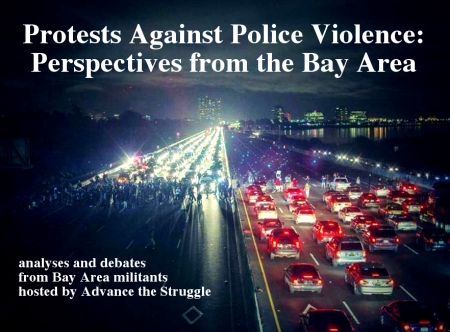December 13th and November 24th
The Millions March, a national solidarity event with the Black Lives Matter movement that took place on December 13th, compels me to address the political dynamics of that nationwide event in order to open a dialogue about the objectives and tactics of the movement. At the beginning of the march, one of the leading speakers called on White Allies of Black people to refrain from speaking on the bullhorn and from marching at the head of the protest; the purpose of this rule was to ensure that black and brown voices were emphasized throughout the march – a theme that was present throughout the march and throughout this movement as a whole.
When we arrived at the Oakland Courthouse, the leaders urged black and brown protesters to stand together on the steps leading to the courthouse and for white protesters to remain at the bottom. When the list of speakers was over, the lead speaker of the march implied in her words that the march was over and that people should head back to the site of the initial convergence to engage in Healing Circles. As the mass of protesters began to move, a black protester announced to the marchers that the march was not over. Indeed, the majority of protesters remained on the streets of Oakland hours after the spectacle at the courthouse.
Now – let’s pause for a moment and rewind three weeks to November 24th, 2014 – the night of the non-indictment of Darren Wilson. On this night we also experienced a powerful display of black, brown and multiracial solidarity; this night, however, was slightly different than the Millions March. People, more or less spontaneously, filled the streets the night of November 24th; during the beginning of the rally on 14th and Broadway, black protesters lead chants of “Black Lives Matter” while people danced in a circle; electricity filled the air as protesters carried out an unpermitted march from downtown Oakland to the 580 Freeway entrance on the north side of Lake Merritt; at some point in the evening, a brave group of young people took over the 580 Freeway, blocking the westward flow of traffic. The people who carried out this first freeway blockade were a mixed racial group of people; black protesters were certainly represented in the mix, contributing to the dynamism of the action; brown, asian and white protesters also filled the gravel laden lanes of the highway. All protesters were clear in their messaging: black lives matter, and police violence must end.
Our intention is to explore the way in which movements such as that experienced by us in the winter of 2014 can contribute to the development of a revolutionary situation in the US; further, we see the questions of racial empowerment, identity and solidarity to be of central importance in building movements against state violence and building revolutionary organizations.



You must be logged in to post a comment.